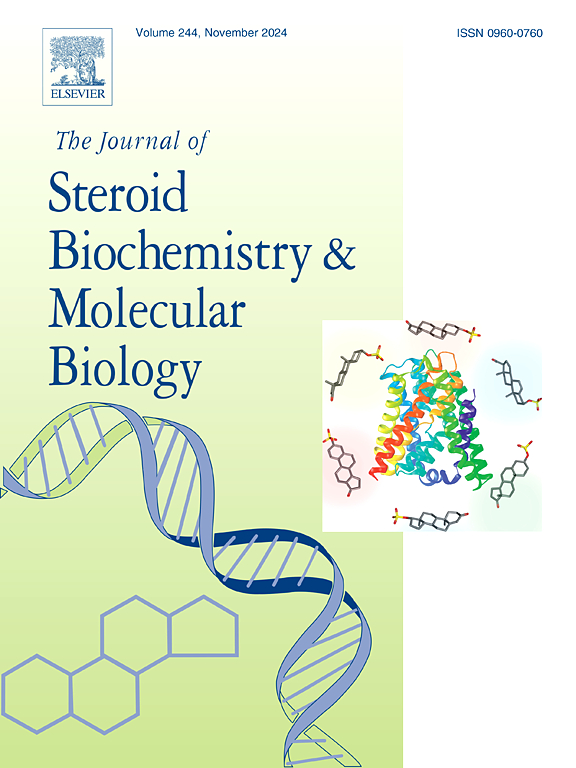肿瘤细胞中表油菜素内酯相互作用伙伴的多靶点分子对接研究及与这些伙伴相关的细胞死亡机制的体外评估
IF 2.5
2区 生物学
Q3 BIOCHEMISTRY & MOLECULAR BIOLOGY
Journal of Steroid Biochemistry and Molecular Biology
Pub Date : 2025-08-24
DOI:10.1016/j.jsbmb.2025.106845
引用次数: 0
摘要
阐明天然代谢物的作用机制可能有助于替代候选疗法的出现。本研究采用硅分子对接(MD)和体外分析相结合的方法,研究了24-表油菜素内酯(EBR)作为类固醇来源的植物激素在癌细胞中的相互作用伙伴,并评估了这些伙伴的细胞死亡机制。使用AutoDock Tools-1.5.7受体配体MD软件,针对选定的35种可能与类固醇相互作用的功能靶蛋白,初步计算EBR评分函数。在乳腺癌、胰腺癌和肝癌细胞系中进行了分子分析。结果表明,视黄酸核受体γ (RARγ)是具有结合能(BE)的最稳定的相互作用伙伴。此外,二次模拟分析获得了RARγ选择性激动剂化合物中EBR的最低BE分数。根据我们的数据,EBR显著抑制MDA-MB-231、MIA-PaCa-2和Hep-G2细胞的细胞活力,并降低了集落形成的潜力。我们发现,增加EBR浓度后,RARγ通过影响下游靶标p21、p16、p27、p57和cyclin D1的表达而被抑制。我们还研究了EBR治疗对核激素受体(NHR)表达、凋亡、内质网应激和希波- yes相关蛋白(YAP)/ pdz结合基序(TAZ)信号通路相关蛋白表达水平的影响。我们的研究结果表明,EBR是一种强内质网应激调节剂,以caspase依赖的方式诱导凋亡,并通过与视黄酸受体相互作用调节Hippo-YAP-TAZ信号通路。本文章由计算机程序翻译,如有差异,请以英文原文为准。
In silico multitargeted molecular docking study of interacting partners of epibrassinolide in cancer cells and in vitro evaluation of cell death mechanisms associated with these partners
Elucidating the mechanisms of action of natural metabolites may be promising in the emergence of alternative candidate therapeutics. In the present study, the combined approaches of in silico molecular docking (MD) and in vitro analyses were conducted to investigate the interacting partners of 24-epibrassinolide (EBR) as a steroid-derived phytohormone in cancer cells and evaluate the cell death mechanisms associated with these partners. EBR scoring functions were initially calculated against the selected 35 functional target proteins, which may interact with steroids, for tumor biology using AutoDock Tools-1.5.7 receptor-ligand MD software. Molecular analyses were carried out in breast, pancreatic, and hepatocellular carcinoma cell lines. Our results showed that the retinoic acid nuclear receptor γ (RARγ) was the most stable interacting partner with a binding energy (BE). Furthermore, the secondary simulation analyses obtained the lowest BE score for EBR among RARγ selective agonistic compounds. According to our data, EBR was significantly inhibited the cell viability of MDA-MB-231, MIA-PaCa-2, and Hep-G2 cells, and diminished the colony formation potential. We showed that RARγ was inhibited after increasing concentration of EBR, by affecting the downstream target’s expressions including p21, p16, p27, p57 and cyclin D1 detected by qRT-PCR. We also investigated the effect of EBR treatment on the expression levels of the proteins linked to nuclear hormone receptor (NHR) expressions, apoptosis, endoplasmic reticulum stress, and Hippo-Yes-associated protein (YAP)/ Transcriptional coactivator with PDZ-binding motif (TAZ) signaling pathways. Our findings indicated that EBR is a strong ER stress modulator, apoptosis inducer in a caspase-dependent manner, and effector for the modulation of Hippo-YAP-TAZ signaling pathways through the interaction with retinoic acid receptor.
求助全文
通过发布文献求助,成功后即可免费获取论文全文。
去求助
来源期刊
CiteScore
8.60
自引率
2.40%
发文量
113
审稿时长
46 days
期刊介绍:
The Journal of Steroid Biochemistry and Molecular Biology is devoted to new experimental and theoretical developments in areas related to steroids including vitamin D, lipids and their metabolomics. The Journal publishes a variety of contributions, including original articles, general and focused reviews, and rapid communications (brief articles of particular interest and clear novelty). Selected cutting-edge topics will be addressed in Special Issues managed by Guest Editors. Special Issues will contain both commissioned reviews and original research papers to provide comprehensive coverage of specific topics, and all submissions will undergo rigorous peer-review prior to publication.

 求助内容:
求助内容: 应助结果提醒方式:
应助结果提醒方式:


